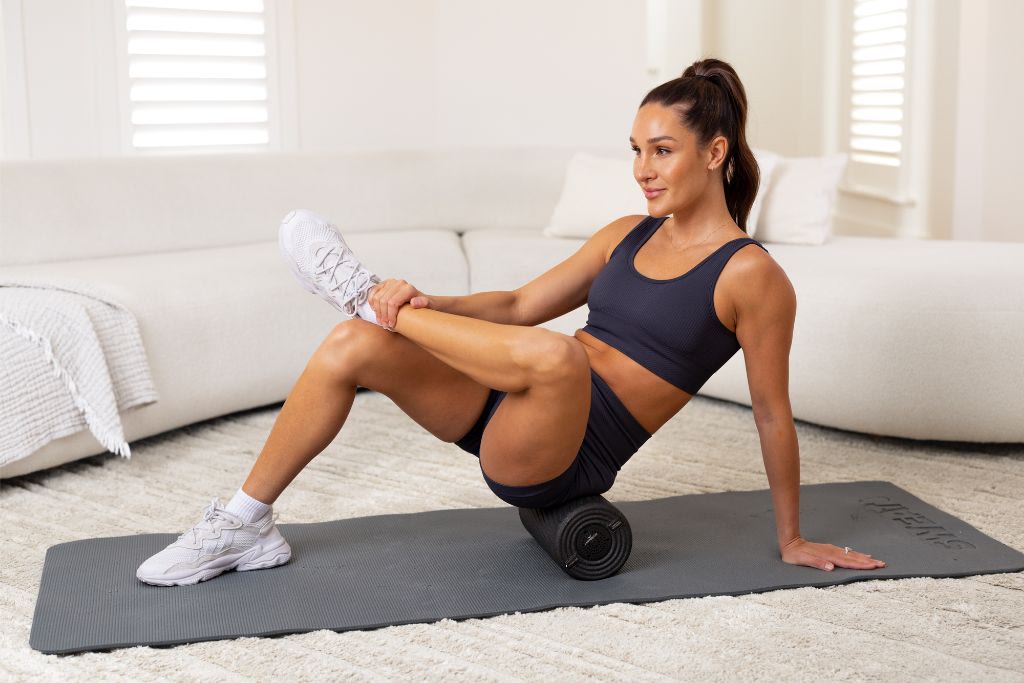The Benefits of Foam Rolling

May 26, 2017

Whether you’ve just started a new Sweat program, are coming back to exercise after a break, or simply push yourself during your workouts, it’s normal to have achy muscles for a day or two after you work out.
DOMS or delayed-onset muscle soreness can occur when you’re using new muscles, fatiguing your muscles more than usual, or using your muscles in a different way than what you’re used to.
Combined with adequate rest and good nutrition, foam rolling can be a great way to aid muscle recovery. If you want to ease soreness, a foam roller could be your new best friend!
What are the benefits of foam rolling?
Foam rolling is one way to alleviate DOMS, but it actually has a wider range of benefits.
You can do a foam rolling session before a workout, as part of your cool down or as an active recovery session.
Foam rollers usually come in cylinder shapes, either smooth or with texture to increase pressure, or you can try a recovery ball for a more targeted massage.
It might help to think of foam rolling as a way to massage your body — it’s also called self-myofascial release — giving you similar tension and muscular relief.
Here are some of the benefits of foam rolling.
Reduce muscle soreness
Foam rolling massages the muscles and fascia - the tissue that connects your muscles and helps hold them, and the rest of your body, in place.
This can help to release tightness or soft tissue restrictions, as well as increase blood flow and oxygen to the tissues, which may have a positive effect on how your body feels and help reduce pain and muscle soreness.
Improve flexibility and range of motion
Together with stretching, foam rolling can help improve your flexibility and range of motion.
A 2019 meta-analysis published in Frontiers in Physiology compared the effects of foam rolling before or after exercise on performance, flexibility and muscle pain. Findings suggest that rolling can be an effective strategy for short-term improvements in flexibility without decreasing muscle performance.
A small 2013 study from the Memorial University of Newfoundland, Canada, found foam rolling could lead to a short-term increased range of motion from joints. While other studies also support this idea, more research is needed to fully understand how foam rolling may improve range of motion.
Prevent injury and improve performance
Tight muscles can be more prone to injury, so self-release of muscles and fascia can help loosen everything up, allowing the tissue to become more supple and move with more fluidity.
Some research, such as a 2015 review published in the International Journal of Sports Physical Therapy, have also suggested foam rolling may be an effective method pre and post-exercise muscle performance.
How do foam rollers work?
Foam rolling works by massaging to release muscle and fascial tightness.
The roller applies pressure, helping to manipulate and break up “knots”, stiffness and tension that can form in your muscles and tissue.
To use a foam roller, slowly run the roller down stiff muscles, using your body weight to apply as much pressure as feels comfortable. Common areas of the body to foam roll include your calves, hamstrings, quads, Iliotibial (IT) bands and middle back.
Slow and steady is key. Start by rolling along the length of the muscle, then you can follow up with smaller targeted rolling motions over any spots that are tender.
Take long breaths as you roll, both to help you relax and to increase the flow of blood and oxygen to your muscles. Many foam rollers have raised sections or a bumpy texture, which can create extra pressure.
Tips for using foam rollers
If you’re new to foam rolling, it can be slightly uncomfortable when you start, especially when you roll over tight muscles.
Go lightly if you find an area particularly painful — decrease the pressure slightly by taking some of your weight off the roller, or work on the surrounding tissue instead.
If you find your muscles are too sensitive, it might be time to take a rest day and allow yourself to recover.
Add foam rolling to your weekly workouts
Whether you’re new to fitness or you’ve been training for a while, foam rolling can be a useful recovery tool to add to your workout schedule. Foam rollers can also be used to support some postures during yoga or Pilates, so they are a fantastic addition to your at-home workout kit too!

A more empowered you starts with Sweat, and our editorial team is here to bring you the latest fitness tips, trainer recommendations, wellbeing news, nutritional advice, nourishing recipes and free workouts.
* Disclaimer: This blog post is not intended to replace the advice of a medical professional. The above information should not be used to diagnose, treat, or prevent any disease or medical condition. Please consult your doctor before making any changes to your diet, sleep methods, daily activity, or fitness routine. Sweat assumes no responsibility for any personal injury or damage sustained by any recommendations, opinions, or advice given in this article.
Fitness